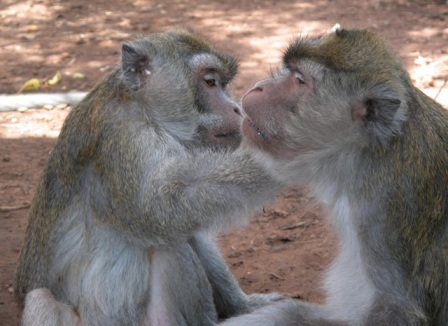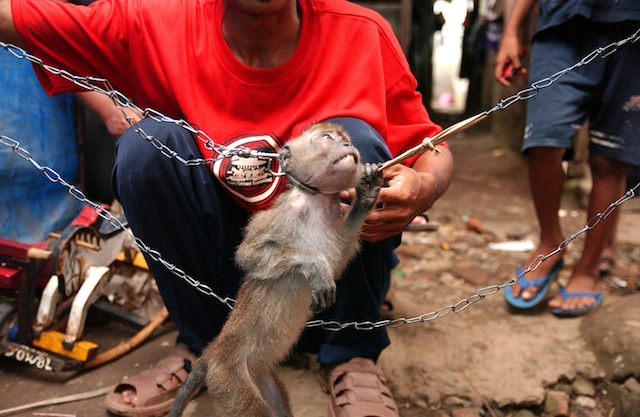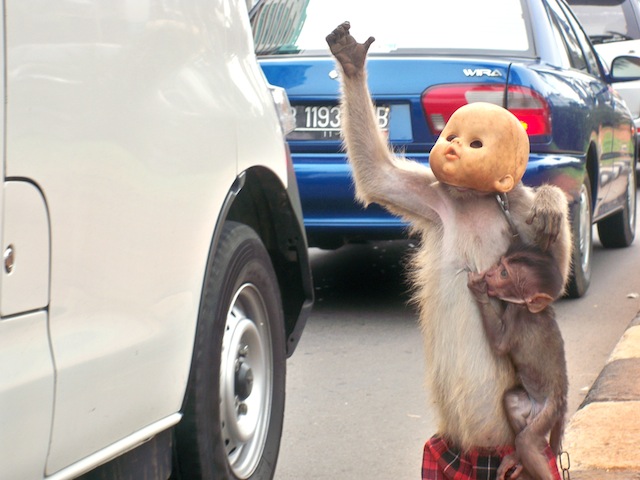Action for Primates

|
Action for Primates |

|
|
There is a growing awareness regarding the exploitation of non-human primates and other wild animals as 'entertainment'. Unfortunately, many people remain unaware of the mistreatment, deprivation and suffering that goes on behind the scenes. Whereas the human audience may be 'amused', the animals certainly are not. The anxiety or fear they experience and any physical suffering they endure are not offset by any benefits to them.
Of great importance is the implicit message sent by such use of non-human primates. Children and others are 'taught', by example, that it is acceptable to use these animals for any purpose, regardless how trivial and even when such use is degrading to the dignity of the animals involved or is potentially dangerous.
Depriving non-human primates of their freedom, native habitat, family and social group is cruel. Forcing them to perform unnatural acts, being continually handled and having close contact and interaction with people involves immense suffering and is extremely stressful for these wild animals (Akbar & Evans 2023).
There are several areas in which non-human primates are used as 'entertainment': advertising campaigns, movies and television shows, live shows, as props for photographs and in zoos (see separate page for the latter).
Organisations such as the American Society of Primatologists (ASP 2021), Association of Zoos & Aquariums (AZA 2008), and the International Primatological Society (IPS 2021) are opposed to using non-human primates as 'entertainment', largely because it is considered cruel.
Although the use of non-human primates in advertising campaigns, movies and television shows may have decreased, it still occurs. One company, Animals in Motion in the USA, boasts an animal "inventory" that includes non-human primates, elephants and giraffes, and advertises the following:
We specialize in animal rentals and training for both exotic and domestic animals for motion pictures, television, special events, private parties such as birthdays, weddings and corporate parties and of course annual nativity scenes.
The primate species most used in films and TV are capuchins and chimpanzees, but baboons, gibbons, macaques and orangutans are also victims of this business. Recent examples include a grivet monkey used in a film starring the Egyptian actor, Ibrahim El Samman, and a tufted capuchin used in the US TV drama 'I Know this Much is True' (HBO). In the case of Samman, when he took the chained monkey onto a live Egyptian TV talk show to promote his film, the monkey attacked the co-host.
In the case of films, it is often claimed that the animals used are treated 'safely and humanely' and that an animal welfare organisation is on hand during filming. The problems with using non-human primates – or any captive wildlife – in this way, however, cannot be alleviated by having someone from an animal welfare organisation present. Regardless if they have been in captivity for a long period or have been born in captivity, these animals are still wild animals. Non-human primates have complex behavioural, social and psychological needs that cannot be met in any meaningful way in captivity or when used in situations to 'entertain' people.
USA: One attraction at state fairs and other public events involves capuchin monkeys being forced to ride on the backs of dogs or sheep to 'entertain' the crowds. One such white-headed capuchin (Cebus capucinus), called Whiplash and known as the 'cowboy monkey', is paraded around on the back of dogs or sheep at rodeos across the country. Other capuchin monkeys are featured in the Banana Derby. Described as "monkey jockeys", they are dressed in jockey outfits and made to ride on the backs of dogs at state fairs and other events. Still others are abused as part of Tim "Wild Thang" Lepard and Team Ghostriders, attached to the backs of dogs, dressed as 'cowboys', while the dogs 'round up' sheep.

In some other countries, especially in Asia, tourist attractions at parks, zoos and other outlets, will often have live shows featuring 'performances' by a variety of wild animals, including non-human primates. The animals may be forced to wear costumes or perform manoeuvres which are mostly unnatural, such as riding bicycles, 'dancing' or walking or standing on their hind legs for long periods. Bipedal walking (walking on hind legs) is not natural for monkeys and can lead to long-term damage to joints and muscles. In order to get the monkeys to adopt this abnormal posture, the monkeys may be hung upside down or forced to stand up straight with the use of chains or be punished (photo). Other aversive measures such as physical violence or deprivation of food or water may be used in most cases to cause fear, intimidation and a feeling of helplessness or else the animals will not 'perform' or will be too dangerous to handle. Even if positive reinforcement is used for training, the animals have no understanding of what is going on and are not 'performing' because it is fun for them. They do what they do either out of fear or in order to get a reward.
Examples of how non-human primates are exploited and abused for 'entertainment' purposes in live shows:
Japan: Japanese macaques (Macaca fuscata) are made to wear face masks and costumes and forced to carry out acrobatics and tricks to amuse people in what is known as 'Sarumawashi' (monkey dancing or performance) (Ebersole 2020).

Indonesia: The use of monkeys to 'perform' for people on the street is common (Owens 2011). The practice is known as 'topeng monyet' or 'masked monkey' (Castrodale 2020). Long-tailed macaques (Macaca fascicularis) are dressed up, often with dolls' heads clamped on their heads (photo) and forced to 'perform'. Food deprivation and physical violence are common 'training' methods used.
Thailand: There are numerous shows where non-human primates, including pig-tailed macaques (Macaca nemestrina), dressed up in colourful clothes and wearing make-up, are forced to 'entertain' visitors.
There are also 'attractions' known as monkey 'training' centres in Thailand, where pig-tailed macaques are forced to perform tricks such as riding bicycles or playing basketball to entertain tourists.
Great apes are abused and forced to 'perform' at places like the controversial Safari World in Thailand. The latter, a 'zoo' in Bangkok, hosts 'orangutan boxing' sessions where the apes (Pongo sp) appear to fight to entertain tourists (Ardehali 2017).
In all cases where non-human primates are kept in captivity and used as 'entertainment' for people, the animals are unquestionably deprived of a normal life. Infants are often removed from their mothers at birth or soon after. They are usually kept in poor conditions, often tethered in between shows. Their teeth and nails may be removed to make them easier to handle (Ajax & King 2020; Garrod 2016). They may even have their tails removed to make it easier to put on diapers (Ajax & King 2020). Such treatment is cruel and leads to severe psychological problems, stress and distress. Furthermore, non-human primates may live for many years, far beyond when they are considered 'cute' and 'adorable', which are often requisite traits for their use. When they are no longer useful, they may be killed or consigned to a life in captivity, in a private home or zoo.
There is also the potential of disease transmission from these non-human primates to people (Schillaci et al 2005). Although the non-human primates may not be ill themselves, they may be shedding viruses that could infect people who come into contact with them. This would not occur when the animals are living freely in their natural habitat.
The best way to end this exploitation and abuse is for people to voice their objections every time a non-human primate is in a captive situation and being used as 'entertainment' and to boycott all situations or products involved. Avoid tourist attractions that involve captive wildlife and submit complaints to tourist and embassy outlets in individual countries as well as to travel and holiday companies. World Animal Protection have prepared a report on how to travel humanely and responsibly (WAP 2022). Producers of movies or television shows using these animals need to be contacted and told that such use is unacceptable. The same should be done when non-human primates are used in advertisements. We know these expressions of public concern are successful because companies have responded positively, with promises to discontinue this practice in future promotions.
Governmental agencies should be contacted and urged to effect a ban on keeping these animals in captivity.
...ASP discourages all individuals from privately owning primates for non-scientific or non-educational purposes and from breeding and selling or otherwise supplying nonhuman primates for non-scientific or non-educational purposes.
![]()
![]()
![]()
![]()
![]()
Contact us via E-mail
Copyright © 2020-2026 Action for Primates. All rights reserved.